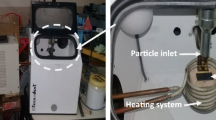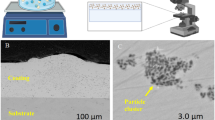To improve the abrasive wear resistance of titanium alloys, ZrB2-containing protective coatings are deposited by electrospark alloying (ESA). As electrode materials, composite ceramics with different amounts of ZrB2 are used. Some of the coated samples are also subjected to laser treatment to improve the coating by structuring the surface as alternating laser fusion tracks and nonfused sparkdeposited areas. The microstructure and phase composition of the coatings are characterized. The surface layer of the worn laser fusion tracks is found to have increased hardness (up to 22–38 GPa), which is two to four times higher than that of the surface before abrasion (~9.5 GPa).
Similar content being viewed by others
References
V. A. Lavrenko, A. D. Panasyuk, and I. A. Podchernyaeva, “High-temperature oxidation of composite AlN–ZrB2–ZrSi2 ceramics,” Powder Metall. Met. Ceram., 47, No. 1–2, 151–156 (2008).
R. Siegel and C. M. Spuckler, “Analysis of thermal radiation effects on temperatures in turbine engine thermal barrier coatings,” Mat. Sci. Eng. A, 245, No. 2, 150–159 (1998).
V. M. Fedirko, I. M. Pogrelyuk, and O. I. Yas’kiv, “Formation of functional coatings by thermal diffusion saturation on titanium based on interstitial compounds,” Fiz. Khim. Mekh. Mater., 42, No. 3, 17 (2006).
Z. Chen and Y. Zhou, “Surface modification of resistance welding electrode by electro-spark deposited composite coatings. Part I. Coating characterization,” Surf. Coat. Techn., 201, No. 3–4, 1503–1510 (2006).
I. A. Podchernyaeva, A. D. Panasyuk, D. V. Yurechko, et al., “Surface modification of AL9 alloy by electric-spark alloying with materials of the AlN–Ti(Zr)B2–Ti(Zr)Si2 system,” Powder Metall. Met. Ceram., 43, No. 3–4, 156–162 (2004).
O. N. Grigor’ev, B. A. Galanov, V. A. Kotenko, et al., “Stability of B4C–VB2 composites in abrasive wear and friction with steel,” Ogneupory Tekh. Keram., No. 10, 2–8 (2005).
V. M. Shulaev, A. A. Andreev, and G. N. Kartamazov, “On effect of hardness increase in molybdenum nitride coatings,” in: Issues of Atomic Science and Engineering, Ser. Vacuum, Pure Materials, Superconductors (15) (Collected Scientific Papers) [in Russian], No. 1, Kharkov (2006), pp. 195–198.
Z. B. Wang, N. R. Tao, S. Li, et al., “Effect of surface nanocrystallization on friction and wear properties in low carbon steel,” Mat. Sci. Eng. A, 352, No. 1–2, 144–149 (2003).
I. A. Podchernyaeva, A. D. Panasyuk, S. S. Zatulovskii, et al., “Structurization and mass transfer of wearresistant coatings in electrospark alloying of Al–Si-alloys with LaB6–ZrB2 composite ceramics,” Sverkhtverd. Mater., No. 6, 50–59 (2003).
I. V. Galinov and R. B. Luban, “Mass transfer trends during electrospark alloying,” Surf. Coat. Techn., 79, No. 1–3, 9–18 (1996).
N. Parkansky, R. L. Boxman, and S. Goldsmith, “Development and application of pulsed-air-arc deposition,” Surf. Coat. Techn., 61, No. 1–3, 268–273 (1993).
A. B. Lyashchenko, V. N. Paderno, B. V. Filippov, and A. A. Adamovskii, “Effect of modification on the strength of grains of zirconium dodecaboride-based material,” in: Proc. 1st Int. Conf. Materials Science of Refractory Compounds: Achievements and Problems [in Russian], Kiev (2008), p. 114.
T. E. Eckert, Ternary Phase Equilibria in Transition Metal–Boron–Carbon–Silicon Systems, Rep. Air Force Materials Laboratory, AFML-TR-65-2, Contract USAF 33(615)-1249, Part II, Ternary Systems, Volume XII, Ti–Zr–B System. Investigation of Pseudobinary Systems ZrB2–NbB2, ZrB2–TaB2, and HfB2–NbB2, Wright-Patterson Air Force Base, Ohio (1966), pp. 1–47.
S. Otani, T. Aizawa, and N. Kieda, “Solid solution ranges of zirconium diboride with other refractory diborides: HfB2, TiB2, TaB2, NbB2, VB2, CrB2,” in: Proc. ISBB2008 16th Int. Symp. Boron, Borides and Related Materials (September 7–12, 2008, Matsue), Matsue (2008), p. 91.
Author information
Authors and Affiliations
Corresponding author
Additional information
Translated from Poroshkovaya Metallurgiya, Vol. 48, No. 5–6 (467), pp. 88–99, 2009.
Rights and permissions
About this article
Cite this article
Podchernyaeva, I.A., Panasyuk, A.D., Panashenko, V.M. et al. Abrasive wear of ZrB2-containing spark-deposited and combined coatings on titanium alloy. I. microstructure and composition of ZrB2-containing coatings. Powder Metall Met Ceram 48, 316–325 (2009). https://doi.org/10.1007/s11106-009-9126-7
Received:
Published:
Issue Date:
DOI: https://doi.org/10.1007/s11106-009-9126-7




